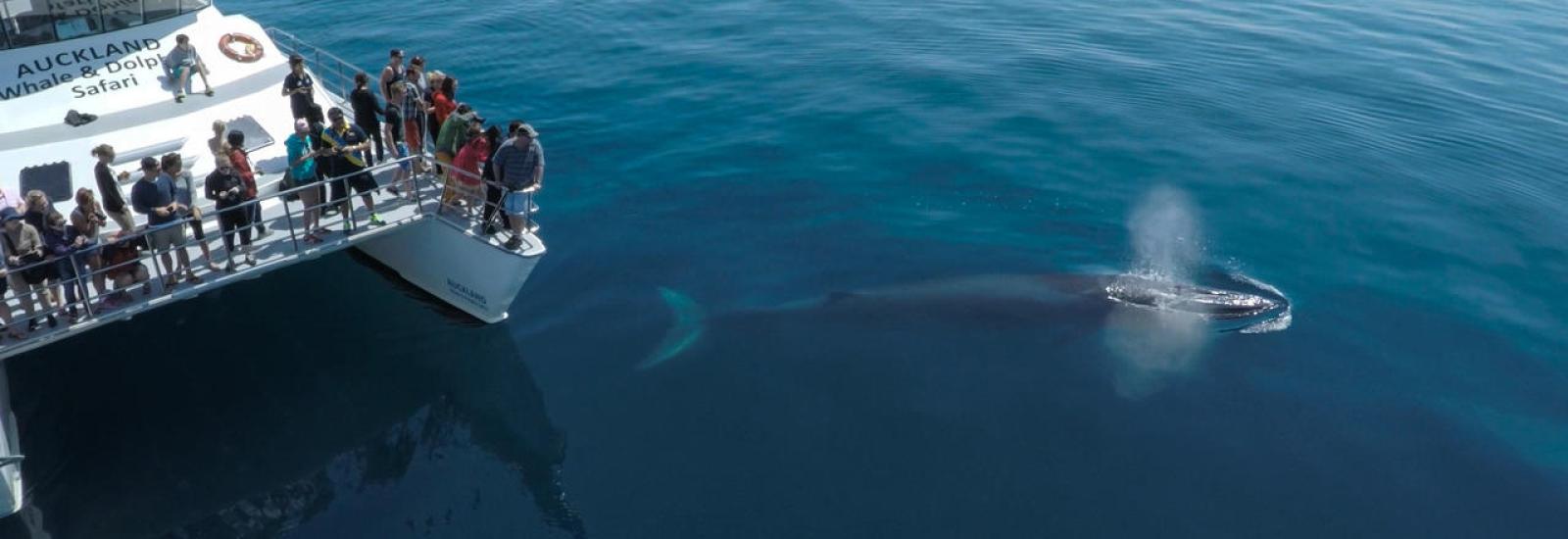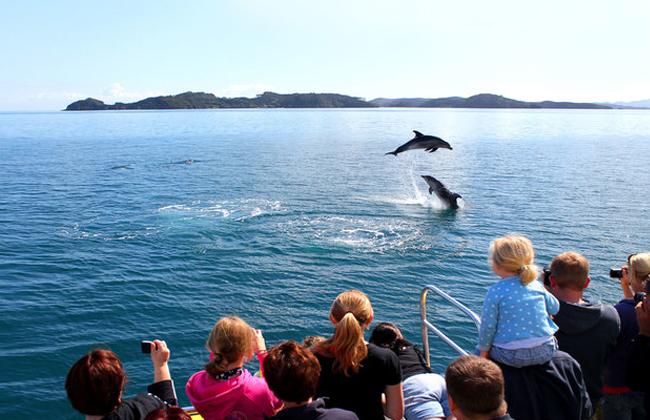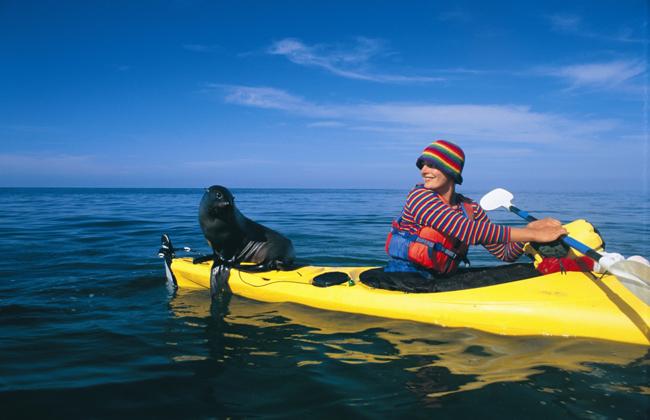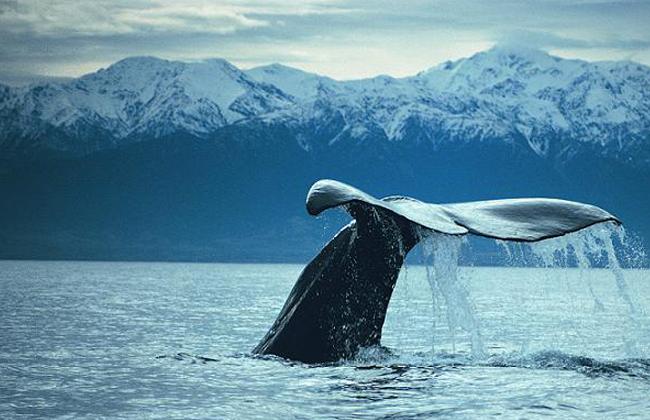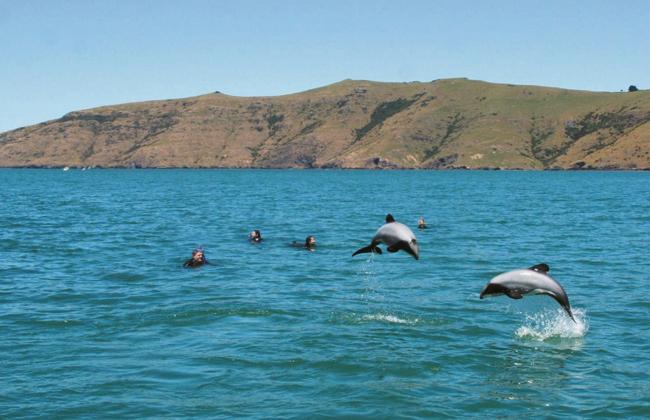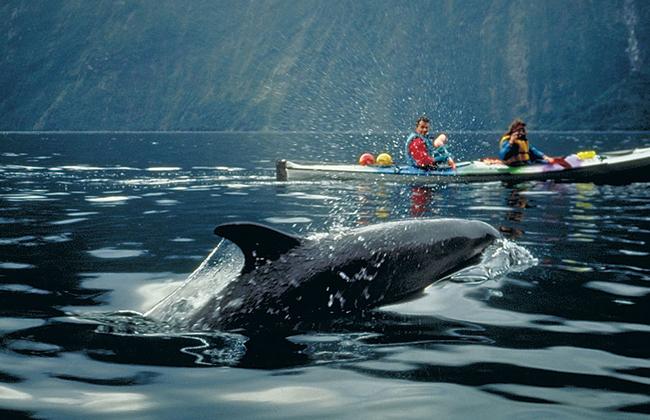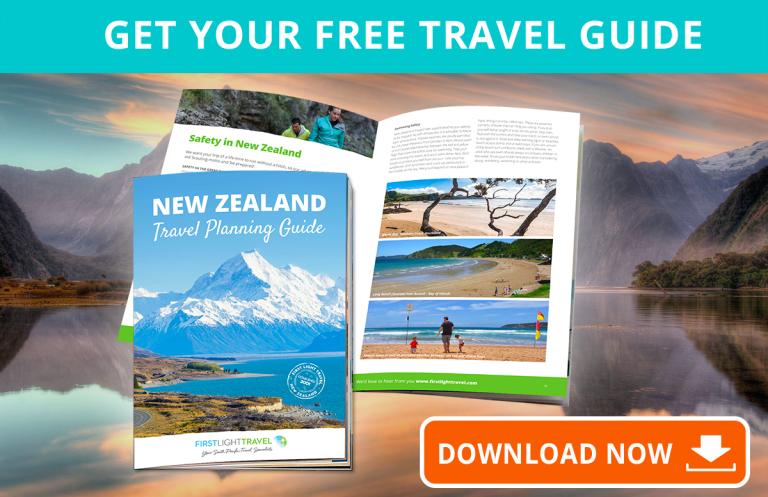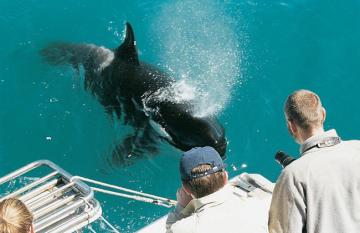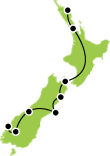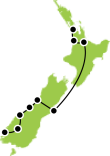
Cetaceans are the stuff of legends. Whether we’re talking about dolphins boosting alongside boats and backward-somersaulting in play, or whales majestically breaching the surface before plunging into the depths to feed, these sleek, intelligent creatures have mesmerized people throughout history.
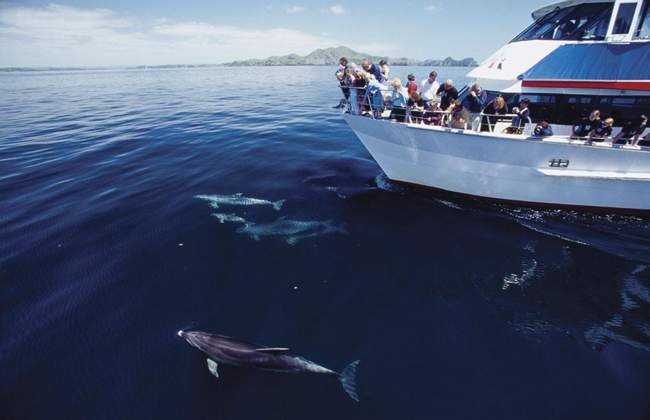
Encountering them in the wild on their own terms is an exhilarating experience and it’s no secret that New Zealand is a hotspot for whales and dolphins. Around half of the world’s approximately 80 species are found in New Zealand waters, and you can get up close and personal by boat, by plane – or, for the more adventurous, in the water with them. Marine encounters can form an unforgettable part of any self-drive New Zealand holiday – and there are plenty of chances throughout the country to slot them into your trip! Below, we’ve listed the best places to encounter whales and dolphins on a New Zealand self drive vacation.
Bay of Islands
The Bay of Islands with its sunny climate, warm sparkling waters and massive population of dolphins, is an ideal place to get on a cruise boat and view dolphins in their natural habitat. The short-beaked common dolphins with their beautiful white or tan flanks can be seen cruising and leaping here in their thousands, orca abound, and the Northland bottlenose dolphin also frolics in this area. During summer and autumn (January – April) the bottlenose prefers the outer waters of the Bay of Islands, but at other times they hug the shoreline, swimming even closer into shore than common dolphins. Passing whales include the blue, humpback, Bryde’s, sei and minke. Most dolphin and whale cruise boat tours leave from Paihia in the Bay of Islands. Paihia is just across the channel from New Zealand’s historic capital, Russell, well worth exploring before or after your dolphin and whale encounter. It is no longer possible to swim with dolphins in the Bay of Islands after research showed that interaction with humans was disrupting the dolphins' natural behaviour. But you can still witness the magic of dolphins playing in the waves from a safe distance on board a vessel.
Abel Tasman National Park
At the northern tip of the South Island lies the Abel Tasman National Park. The headlands in this region are cloaked in verdant forest, its pristine beaches are lapped by turquoise sea, and to top it off this region gets the highest sunshine hours in the country – bliss! The Abel Tasman is well known for its 3-to-5-day walking track through forest and secluded inlets, but the surrounding sea itself is rich with marine life and can be explored by kayak, cruise boat, sailboat or water taxi. The dolphins generally seen here are short-beaked common dolphins. There are also fur seals residing on Pinnacle and Tonga Islands, which have cuteness factor through the roof with their long whiskers, pointy snouts and large eyes.
Kaikoura
Further south from Abel Tasman on the east coast of the South Island lies Kaikoura – home of fresh-caught crayfish by the roadside and Seafest, the annual food and wine festival. It is also perhaps New Zealand’s most famed cetacean viewing location. Here you can see sperm whales (the world’s largest toothed whale at more than 15m long) at any time of the year, humpbacks in June and July, and orca in the summer. There’s also a seal colony. It’s almost a guarantee that you’ll see dusky dolphins in Kaikoura on any given day – this species are renowned for their particularly exuberant and gravity-defying acrobatics, slipping expertly through the water in pods numbering anything from 100 to 1,000 members. The dolphins and whales all flock to Kaikoura’s unique underwater landscape, which provides them the perfect feeding environment. The continental shelf here plunges hundreds of metres down into underwater canyons, and it is also where two currents – warm and icy cold – meet. This collision results in an upwelling of nutrients and deep-sea species that provide food for many. The sperm whale alone eats around a ton of fish and squid every day! To get closer to dolphins and whales in Kaikoura, you can take a flight or a cruise boat – many boats offer swim-with-the-dolphins opportunities.
Akaroa
After Kaikoura, continue driving south down the coast to picturesque Akaroa, where you can spot rare dolphins amidst the beauty of the Banks Peninsula. Akaroa itself is a historic French settlement, packed with funky art galleries, historic houses, and a myriad of cafes serving French-inspired cuisine. The harbour is the extinct crater of a volcano, with volcanic cliffs that jut up from the ocean. In this awe-inspiring setting, you can take a harbour cruise to spot the rare Hector’s dolphin, resident in the harbour’s marine mammal sanctuary. The Hector’s is the world’s smallest ocean-going dolphin and is found only in New Zealand. This tiny cetacean – only 50 kilos and 1.4 metres long – is also the rarest, and so having the opportunity to see and swim with them is a true privilege.
Fiordland National Park
Heading to the south-western part of the country, the chilly waters of Fiordland National Park and the Te Wahipounamu World Heritage site are home to marine mammals galore. High rainfall here means water gushes into the fiords, forming a top layer of freshwater 3-4m deep. The freshwater is stained a dark tea colour with tannins from forest leaf litter, and so it allows deep-sea marine life to flourish in relatively shallow water – rare red and black corals can be found at just 15m below the surface. The area itself is breath taking, with sheer cliffs looming skyward on all sides to take your breath away. Take a cruise boat into either Dusky or Doubtful Sound, or if you want to create a truly special adventure, getting there by helicopter over the towering peaks and plunging valleys is an excellent option. In these sounds you can spot the resident bottlenose dolphin populations – one of the southernmost locations in the world. Lighter grey than the dusky, the bottlenose males can grow up to four metres long, much longer than their relatives in the tropics. If you choose to drive through to the iconic Milford sound, take a cruise boat tour to see the dusky and Hector’s dolphins. The southern right whale is also an occasional sight on the Fiordland coast as it migrates past, and other whales have been spotted including the humpback, sperm, minke and even rarer species like Arnoux’s beaked whale.
First Light Travel: are the New Zealand specialists – and we’re passionate about our nature and wildlife.
We can put together a self-drive itinerary tailored to your exact needs; incorporating plenty of encounters with our cheeky dolphins and orcas, so why not consider participating in one of the many dolphin and whale encounters in New Zealand. Get in touch today!
Recent Posts
Blog Categories
Blog archives
- February 2025 (3)
- January 2025 (6)
- December 2024 (12)
- November 2024 (3)
- October 2024 (2)
- July 2024 (2)
- May 2024 (12)
- April 2024 (2)
- March 2024 (2)
- January 2024 (2)
- November 2023 (10)
- October 2023 (4)
- August 2023 (1)
- May 2023 (2)
- April 2023 (2)
- March 2023 (17)
- February 2023 (4)
- January 2023 (4)
- December 2022 (11)
- November 2022 (7)
- October 2022 (1)
- May 2022 (1)
- March 2022 (3)
- February 2022 (3)
- January 2022 (1)
- December 2021 (1)
- August 2021 (1)
- June 2021 (1)
- May 2021 (2)
- February 2021 (1)
- August 2020 (1)
- July 2020 (1)
- May 2020 (1)
- April 2020 (1)
- March 2020 (1)
- January 2020 (1)
- December 2019 (1)
- November 2019 (1)
- October 2019 (1)
- September 2019 (1)
- August 2019 (5)
- July 2019 (2)
- June 2019 (1)
- May 2019 (3)
- April 2019 (1)
- March 2019 (1)
- February 2019 (1)
- January 2019 (1)
- December 2018 (1)
- November 2018 (1)
- September 2018 (1)
- August 2018 (1)
- July 2018 (1)
- June 2018 (1)
- May 2018 (1)
- April 2018 (1)
- March 2018 (1)
- February 2018 (1)
- January 2018 (1)
- December 2017 (1)
- October 2017 (1)
- September 2017 (1)
- August 2017 (1)
- July 2017 (1)
- June 2017 (1)
- May 2017 (1)
- April 2017 (1)
- March 2017 (1)
- February 2017 (1)
- January 2017 (1)
- December 2016 (1)
- November 2016 (1)
- October 2016 (1)
- September 2016 (1)
- August 2016 (1)
- July 2016 (1)
- June 2016 (1)
- May 2016 (1)
- April 2016 (1)
- March 2016 (1)
- February 2016 (1)
- January 2016 (1)
- December 2015 (1)
- November 2015 (1)
- October 2015 (1)
- September 2015 (1)
- August 2015 (1)
- July 2015 (1)
- June 2015 (1)
- May 2015 (1)
- April 2015 (1)
- March 2015 (1)
- February 2015 (1)
- January 2015 (1)
- December 2014 (1)
- November 2014 (1)
- October 2014 (1)
- September 2014 (1)
- July 2014 (1)
- June 2014 (3)
- May 2014 (1)
- April 2014 (1)
- March 2014 (1)
- February 2014 (1)
- January 2014 (1)
- November 2013 (15)
- October 2013 (1)
- September 2013 (1)
- August 2013 (1)
- July 2013 (1)
- May 2013 (1)
- April 2013 (1)
- March 2013 (1)
- February 2013 (1)
- January 2013 (1)
- December 2012 (1)
- November 2012 (2)
- October 2012 (2)
- September 2012 (2)
- August 2012 (2)
- July 2012 (2)
- June 2012 (2)
- May 2012 (2)
- April 2012 (3)
- March 2012 (2)
- February 2012 (2)
- January 2012 (3)
- December 2011 (1)
- November 2011 (1)
- October 2011 (2)
- September 2011 (1)
- August 2011 (1)
- July 2011 (1)
- June 2011 (1)
- May 2011 (1)
- April 2011 (1)
- March 2011 (1)
- February 2011 (1)
- January 2011 (1)
- December 2010 (1)
- November 2010 (1)
- October 2010 (1)
- September 2010 (1)
- August 2010 (1)
- July 2010 (1)
- June 2010 (1)
- May 2010 (1)
- March 2010 (1)
- February 2010 (1)
- January 2010 (1)
- December 2009 (1)
- November 2009 (1)
- October 2009 (1)
- September 2009 (1)
- August 2009 (1)
- July 2009 (1)
- June 2009 (1)
- May 2009 (1)
- April 2009 (1)
- March 2009 (1)
- February 2009 (1)
- January 2009 (1)
- December 2008 (1)
- May 2005 (1)

